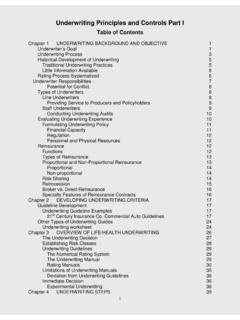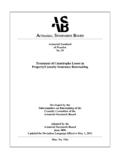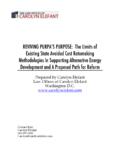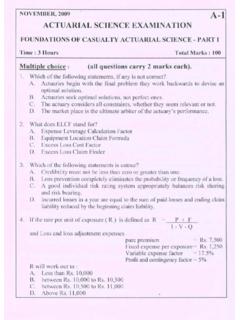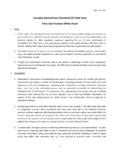Transcription of COMMENTS ON TAX REFORM FOR THE SENATE …
1 April 2015 COMMENTS ON TAX REFORM FOR THE SENATE finance COMMITTEE Americans value clean, safe, and affordable drinking and wastewater services. Water is provided through a network of pipes over 700,000 miles long more than four times the length of the National Highway system. These services are provided by America s water utilities both public and private which treat roughly 34 billion gallons of water every day. The National Association of Water Companies (NAWC) is the voice of the private water service industry. By means of various business models, private water and wastewater professionals serve more than 73 million Americans.
2 Nearly one in every four Americans receives service from a privately owned and regulated water or wastewater utility, or from a municipal utility operating under a public-private partnership. The vast majority of private water service providers are utilities which are overseen and regulated by state regulatory commissions (or PUCs) that determine the rates they charge their customers. Our members are located throughout the nation and range in size from large companies with hundreds of systems in multiple states to individual utilities serving a few hundred customers. Tax REFORM and Regulated Utilities Regulated private water utility companies operate in a rate regulated environment in which the prices at which they deliver their services are set by PUCs.
3 For this reason, the starting point for the private water sector in analyzing tax REFORM options is different than for non-regulated taxpayers. By way of background, the prices charged by private water companies are based on the capital employed and expenses incurred in operating their businesses. PUCs set prices for services so that rates are affordable for customers and private water company shareholders can earn a fair National Association of Water Companies General Statement on Tax REFORM Submitted to the SENATE finance Committee Page 2 of 10 return on their investment.
4 If the costs of capital and taxes on private water companies increase, whether as a result of tax REFORM or otherwise, those increases are passed on to water customers. Under state regulatory rules, private water companies are entitled to the opportunity to earn a fair rate of return on invested capital, and this is a key point that tax policymakers need to keep in mind. Because water companies are effectively pass-through entities with respect to taxes, the effects of tax REFORM eventually, and in some regulatory jurisdictions immediately (such as California and Hawaii), impact water customers dollar-for-dollar.
5 While private water companies work hard to insure that the prices paid by their customers are in line with the prices that are paid by customers of municipally operated water services, tax REFORM may result in rate disparities that have little basis in terms of underlying cost of service and that are difficult for customers to understand. Water touches everything and everyone; it is the unseen and unspoken engine of our economy. Drinking and wastewater infrastructure systems are critical to making everything function. If the cost of water goes up, the cost of living, of growing crops, of manufacturing and all else goes up.
6 When evaluating tax REFORM , private water companies are concerned, above all else, on the impact the REFORM will have on the rates charged to their customers. A significant portion of the cost of service to customers is the cost of capital to support the enormous infrastructure necessary to deliver this service. The water and wastewater industry is highly capital intensive. On average the water and wastewater industry has invested approximately $ of capital for every $ of revenue1. Changes in tax law that have the potential to reduce the cost of service and push down rates would help provide access to capital by reducing pricing pressure on customers and making it possible for PUCs to establish rates that include an increased proportion for capital expenditures.
7 Conversely, tax law changes that increase the cost of capital and the cost of service generally would have an opposite and detrimental effect. In view of the country s massive need for investment in water infrastructure, water companies ask whether tax REFORM will increase or decrease their cost of capital and the rates borne by their customers. Water companies need access to affordable capital to meet the demand for infrastructure improvements. NAWC estimates that its six largest members, collectively, invest $2 billion per year in their systems and those systems serve 6% of the population.
8 Those companies, and all private water companies, have the central business mission of providing a secure and reliable water supply to their customers. Their ability to access capital to improve their systems is critically important. 1 2008 AUS Utility Reports. National Association of Water Companies General Statement on Tax REFORM Submitted to the SENATE finance Committee Page 3 of 10 Drinking and Wastewater Challenges It is no secret that many parts of America s basic infrastructure are outdated, under stress and in need of major capital replacement or repair.
9 Today, America s water infrastructure is more challenged than ever, requiring significant investment; tomorrow those challenges will be even greater. The most recent assessment of the public s water system needs conducted by the Environmental Protection Agency2 concluded that over the 20-year period from 2007 through 2026 the nation s drinking water infrastructure needs would be at least $ billion. In 2013, the American Society of Civil Engineers (ASCE) gave the water and wastewater infrastructure a grade of D, as part of its infrastructure report card. According to the ASCE, if left unchecked, the nation s water infrastructure could cost businesses $147 billion and cost households $59 billion thru 2020.
10 The ASCE also notes that under a worst-case scenario, if water infrastructure problems are not addressed, the could lose, through 2020, nearly 700,000 jobs, $541 billion in personal income, $416 billion in GDP and $6 billion in A report from the Johnson Foundation, Financing Sustainable Water Infrastructure, 4 released in 2012, also found water systems in need of substantial investment. The report indicated that the investments required to meet increasing consumer demand and environmental standards are vast, but not insurmountable. It pointed out that meeting these investment needs would require new financing models and pricing flexibility to pay for new infrastructure and to support existing facilities.

